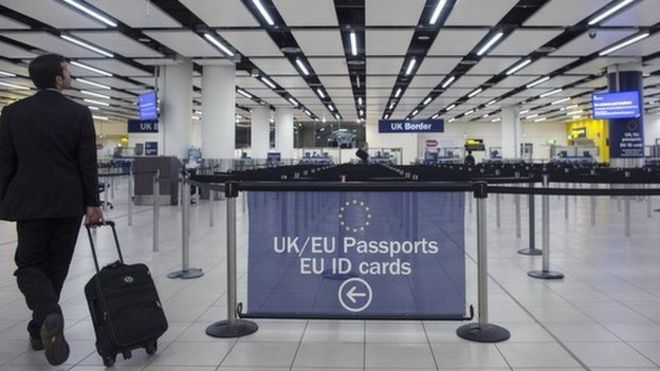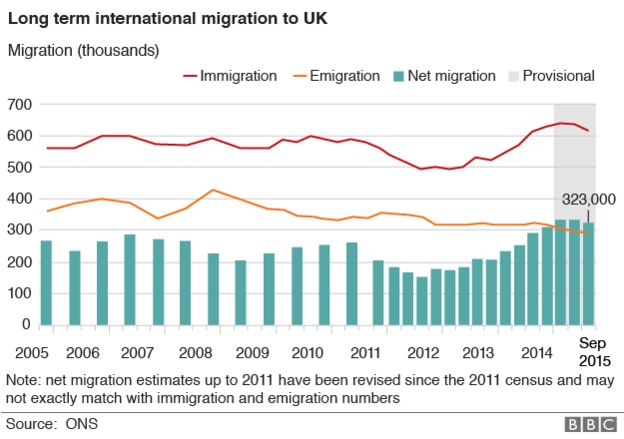

Specific information about the number of EU migrants paying tax and claiming benefits in the UK will be published in the run-up to June’s EU referendum.
The move to release data on the number of National Insurance numbers actively used by EU citizens follows pressure from Eurosceptic MPs and economists.
They have long argued official figures on inward migration from the EU vastly underestimate the true numbers.
Revenue and Customs said it would give a “fuller picture” of migration trends.
The BBC’s deputy political editor Norman Smith said the figures, which could emerge by the end of April, had the potential to have an “incendiary effect” on the referendum campaign.
Voters will decide on 23 June whether the UK should remain in the EU or leave, with immigration expected to be a key battleground.
Those campaigning to leave the EU argue the UK cannot control levels of migration from Europe – which have risen sharply in the past decade – while remaining a member and abiding by the EU’s rules on the free movement of people.
Reality Check: Are NI numbers a good migration measure?

Campaigners to leave the European Union have been badgering the government about the reliability of the official immigration statistics.
Nigel Farage is wondering why, as Jonathan Portes has been pointing out, the Office for National Statistics (ONS) figures for migration to the UK from other EU countries is so much lower than the number of National Insurance numbers allocated to EU nationals.
According to the most recent comparable statistics, migration to the UK from the rest of the EU was 257,000 in the year to September 2015, but during the same period, 655,000 EU nationals registered for National Insurance numbers (Ninos).
Mr Farage smells a rat: “They are pulling the wool over our eyes. Ninos are a simple and clear reflection of the real numbers of people in this country, as without them you can neither legally work, nor claim benefits.”
Now the government has promised to tell us how many of the Ninos issued are still active – in other words, how many of the EU citizens who registered are currently paying UK tax or claiming benefits. But are Ninos a good measure of immigration?
But those pushing to stay in the EU argue that the UK, which is not a member of the Schengen area, does have controls in place and curbs on future in-work benefits for EU migrants negotiated by David Cameron will reduce the “pull factors” attracting people to the UK.
Figures published by the Office for National Statistics suggested that 257,000 EU migrants came to the UK between September 2014 and September 2015.
But other figures for the same period show 630,000 National Insurance numbers were allocated to EU nationals, up 7% on the year before. Of these, 209,000 were from Bulgaria and Romania.
The ONS has said its figures include migrants only in the UK for a short period and are not a “direct measure” of when they arrived in the UK, pointing out that many Bulgarians and Romanians may have been living and working on a self-employed basis in the UK for several years.
‘Better than never’
Economists have long called for details of how many National Insurance (NI) numbers – which are issued to those entitled to study or work to help pay tax and benefits – are being actively used to be released to show the current impact of EU migration on the UK economy and labour market.
MPs have been pushing for information about the number of EU nationals who have paid income tax and NI and received benefits over the last year to be published, as well as information about the nationalities of new NI applicants over the past four years.

Andrew Tyrie, the Conservative MP who chairs the Commons Treasury Select Committee, said he now expected to receive the data by the end of the month, saying it was “late but a good deal better than never”.
“This has been obtained as a result of a good deal of persistence,” he said.
Jonathan Portes, from the National Institute of Economic and Social Research – who first requested the information – said it would show how many EU nationals getting NI numbers in the past four years had remained and what economic contribution they made vis-a-vis the cost to the taxpayer.
“What we are going to find out how many of those are still active – and by active I mean are they claiming benefits or, more likely, are they paying tax?” he told BBC Radio 4’s Today.
“The government’s computer systems can tell us but it is that information that they have so far been very reluctant to release.”
Missed targets
Ministers have sought to explain the discrepancy between the ONS and the NI figures by arguing many workers applying for National Insurance numbers are only in the UK for short-term work.
Downing Street said the prime minister had been pushing for HMRC to issue “greater information” on NI numbers.
Lin Homer, the chief executive of the HMRC, said the data and tax authority’s analysis of it would be published as part of or alongside other ONS figures.
“We are working closely with ONS and will be providing our data and analysis to them once it has been compiled to allow them to combine it with their own data, analysis and quality assurance work and thereby produce a fuller picture,” she said.
According to the British Labour Force Survey, there are now two million EU nationals in the UK workforce, a sharp rise on four years ago.
The Conservatives have consistently missed their target of reducing net migration – the difference between the number of people leaving and arriving – in the UK to below 100,000.
The latest figure, for the year to September, was 323,000.
[Source:- BBC]



